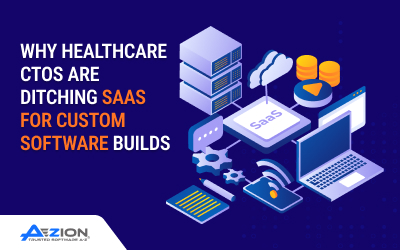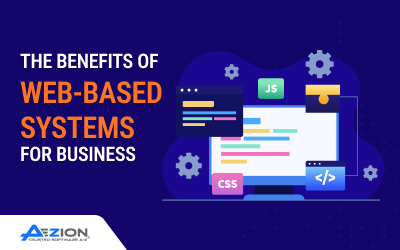Summary
Healthcare CTOs are increasingly reconsidering SaaS (Software as a Service) due to its limitations in customization, data control, and regulatory alignment. While initially appealing for quick deployment and lower costs, SaaS often fails to support long-term clinical and operational needs. Custom healthcare software development is gaining traction as a more sustainable and strategic alternative for modern infrastructure planning.
Introduction
Healthcare IT modernization demands more than just speed; it requires control, compliance, and adaptability. CTOs are under pressure to upgrade systems without disrupting sensitive workflows or compromising data ownership. As SaaS platforms struggle to keep pace with these demands, many leaders are turning to custom-built software IT solutions that better fit evolving care delivery and regulatory frameworks.
SaaS vs Custom Healthcare Software: Which Is Better for CTOs?
SaaS offers a faster launch with predictable subscription costs, but flexibility is often limited. Custom Software development, while requiring more time and upfront investment, gives complete control over design, integration, and data governance. The choice between SaaS and custom software for healthcare CTOs is increasingly driven by long-term goals rather than short-term convenience. Here are a few comparison points for your reference:
| Criteria | SaaS | Custom Software |
| Time To Deploy | Rapid setup with standard configurations | Longer build time, tailored to needs |
| Upfront Investment | Low initial cost, monthly or annual fees | Higher initial cost, planned capital expense |
| Customization | Limited to vendor-defined options | Fully tailored to clinical and operational needs |
| Data Ownership | Often shared or vendor-controlled | Full control and local data residency |
| Regulatory Compliance | Generic, may not meet all regional needs | Built to align with specific compliance mandates |
| System Integration | May not support legacy or in-house tools | Designed for seamless internal system integration |
| Cost Over Time | Recurring subscription and upgrade charges | Predictable long-term ROI and lower TCO |
| Vendor Dependence | High-level feature changes rely on the provider roadmap | None; complete control over updates and roadmap |
Why SaaS Is Failing Healthcare CTOs
SaaS tools often handle basic operations but struggle with the complexity of modern healthcare. What onceoffered speed now creates delays, compliance gaps, and rigid workflows. As demands for growth, security, and system connectivity rise, the weaknesses in SaaS models are becoming increasingly difficult to ignore.
- Limited Customizations for Clinical Workflows: SaaS platforms typically offer predefined workflows that often fail to align with the unique clinical practices of specialized departments. This restricts efficiency, forces the use of workaround solutions, and fails to support the nuanced needs of patient care across various healthcare settings.
- Compliance and Data Residency Constraints: Many SaaS vendors store data across global regions, making compliance with HIPAA, SOC 2, and local data residency laws difficult. This lack of control introduces legal exposure and complicates audits for regulated healthcare environments.
- Poor Interoperability With Legacy Systems: Integrating SaaS with legacy EHRs, imaging tools, or billing systems is often limited or unsupported. This results in fragmented data, duplicated efforts, and reduced coordination across administrative, clinical, and operational teams.
- Unpredictable and Growing Pricing: Although initially affordable, SaaS pricing can escalate rapidly with the addition of users, modules, or storage. These rising costs reduce financial predictability and strain long-term IT budgets, especially in large-scale healthcare environments.
- Vendor Lock-In and Slow Feature Releases: Vendor lock-in in healthcare SaaS delays access to critical features, security patches, or system improvements. This lack of flexibility prevents healthcare organizations from adapting technology to match their evolving clinical and compliance requirements.
Benefits of Custom Healthcare Software for CTOs
As SaaS limitations become more visible, healthcare CTOs are turning to custom-built solutions. These offer better alignment with internal processes, stronger control over data, and a foundation that supports long-term growth, security, and care innovation across departments.
- Tailored Design for Clinical, Operational, and Compliance Goals: Custom software is built around an organization’s exact needs, ensuring clinical workflows, internal operations, and compliance protocols work together seamlessly without forcing teams to adjust to generic system structures.
- Full Ownership of Data and Source Code: With custom systems, healthcare organizations retain full control over patient data, system logic, and infrastructure. This enhances security, streamlines compliance management, and eliminates dependencies on external vendors for core system access.
- Seamless Integration With Internal Systems and Tools: Custom builds can be designed to work with existing EHRs, billing tools, lab systems, and analytics platforms. This enhances data flow, minimizes manual intervention, and facilitates unified operations across all departments.
- Transparent One-Time Investment With Long-Term ROI: Unlike SaaS subscriptions, custom Software involves a one-time build or planned upgrade model. Over time, this leads to better cost control, predictable budgeting, and stronger returns on technology investments.
- Future-Proof Architecture for Scalable Growth: Custom systems support the scalability of healthcare software, allowing for easy updates, module additions, and long-term growth. This ensures alignment with changing care models and evolving regulatory needs.
How Custom Software Simplifies Healthcare Compliance
In healthcare, compliance is non-negotiable. Custom Healthcare Compliance Software provides CTOs with greater control over how data is managed, accessed, and audited. Unlike rigid SaaS tools, custom Software is tailored to meet regulatory standards from the outset, reducing risk and enhancing oversight.
- Meeting HIPAA, SOC 2, and GDPR Requirements: Custom software can be designed to align with specific regulations from day one. This includes data encryption, secure access protocols, and audit-ready reporting for HIPAA, SOC 2, and GDPR compliance without relying on third-party configurations.
- Managing PHI With Role-Based Access and Audit Trails: Custom systems allow fine-grained control over who accesses protected health information. Role-based permissions and detailed audit logs ensure only authorized users interact with sensitive data, reducing exposure and supporting internal accountability.
- Reducing Risk of Breach Through Internalized Control: With full ownership of the system, healthcare organizations can manage infrastructure, updates, and security protocols internally. This internalized control strengthens healthcare data security by reducing reliance on vendors and minimizing breach risks.
Why Healthcare CTOs Are Choosing Custom Software Over SaaS
Beyond technical limitations, broader strategic concerns are accelerating the move away from SaaS. Healthcare CTOs are prioritizing security, data agility, and organizational control areas where custom software provides long-term advantages that align with both clinical needs and executive priorities.
- Escalating Cybersecurity Mandates: Healthcare organizations face increasing scrutiny over data security. Custom Software offers the flexibility to implement advanced controls, adapt to changing regulations, and quickly respond to threats without waiting for vendor updates.
- Real-Time Analytics and Clinical Decision-Making: Custom systems can be built to support unified, real-time data environments. This enables faster reporting, better decision support, and improved patient outcomes across departments and care settings.
- Pressure to Align IT With Care Delivery Models: Static SaaS solutions often fail to support evolving care structures. Custom Software gives CTOs the ability to match IT architecture with value-based care, remote monitoring, and integrated care teams.
- Executive Demand for Cost Transparency and ROI: Recurring SaaS costs make long-term budgeting difficult. Custom Software provides a clear investment model with measurable ROI over time, supporting better financial planning and accountability.
- Need for Greater Data Agility and Ownership: With growing use of data across clinical, financial, and research areas, CTOs want complete control. Custom systems allow internal teams to manage, govern, and use data without third-party limitations.
Key Operational Benefits of Custom Software for Healthcare
Beyond security and compliance, custom healthcare software gives CTOs stronger control over internal operations. With a single unified system, departments collaborate more efficiently, data flows seamlessly, and IT teams maintain tighter oversight. These operational gains directly support care delivery, cost control, and executive decision-making.
- Easier Coordination Between Departments: Custom software connects clinical, billing, pharmacy, and lab systems through shared workflows and data structures. This improves turnaround time, reduces duplication, and eliminates delays caused by disconnected third-party tools.
- Centralized Monitoring, Logging, and Access Control: All user actions, access events, and system changes can be tracked from a single interface. This simplifies security audits and helps IT enforce policies without relying on vendor dashboards.
- Support for Custom ML/Analytics Models: Custom builds can support in-house AI tools, predictive analytics, or operational dashboards by giving teams access to clean, real-time data structured for internal use cases.
- Reduced Reliance on External Vendors: In-house development reduces dependency on external vendor timelines for bug fixes or updates. CTOs gain full control over system performance, uptime, and future enhancements.
When to Choose SaaS in Healthcare IT Strategy
While many organizations are moving toward custom solutions, SaaS can still be effective in specific cases. For early-stage providers or non-critical functions, SaaS offers convenience, low entry cost, and quick setup, especially when customization and deep integration are not immediate priorities
- Small or Early-Stage Providers: New clinics or startups may lack the budget or in-house IT teams to manage complex Software builds. SaaS tools provide essential functions out of the box, enabling providers to go digital quickly without delaying operations or compromising initial care delivery.
- Budget-Constrained Pilots: For limited-scope projects or trial phases, SaaS platforms are ideal for testing workflows or collecting feedback. They allow rapid deployment, avoid capital expenditure, and support early experimentation without locking the organization into long-term technical or financial commitments.
- Non-Core Workflows with Standard Templates: Tasks like HR, employee training, or staff scheduling often follow standard formats. SaaS solutions work well in these areas, offering pre-built modules that meet basic needs without requiring custom logic, clinical integrations, or specialized infrastructure.
Questions Healthcare CTOs Should Ask Before Replacing SaaS
Before moving away from SaaS, healthcare CTOs must assess their internal needs, regulatory environment, and long-term technology goals. These questions help evaluate whether building a custom solution aligns with the organization’s clinical, operational, and financial priorities.
1) Are we locked into vendor pricing or product roadmaps?
If your costs increase unpredictably or needed features depend on vendor timelines, you’re likely experiencing lock-in. This reduces flexibility and slows your ability to respond to clinical or regulatory changes.
2) How important is full data control to our goals?
If your organization handles sensitive patient data or operates across jurisdictions, full ownership over data storage, access, and governance is critical, something SaaS tools may limit due to shared hosting models.
3) Can our SaaS tools scale with regulatory or clinical changes?
Evaluate whether your current stack supports emerging care models or stricter compliance standards. SaaS systems often struggle to adapt to new policies, resulting in misalignment with future mandates.
4) Are current workflows being restricted by rigid software templates?
If staff use workarounds to bypass limitations or systems don’t reflect your operational logic, custom Software may be the only way to align IT with real-world processes.
5) Do we have internal capabilities or partners to support custom builds?
Consider whether your team or a trusted development partner can manage long-term support, updates, and scaling. Custom solutions require active governance but offer strategic independence in return.
Final Thoughts: Custom Builds vs SaaS in Healthcare
The shift toward custom healthcare software development marks a strategic realignment in how CTOs approach infrastructure, compliance, and clinical systems. SaaS may offer speed, but it often falls short in terms of long-term control, security, and interoperability. Custom-developed Software builds provide a scalable architecture and fuel healthcare digital transformation through features such as full data ownership, flexible system control, evolving regulatory standards, and enterprise-wide integration.
Frequently Asked Questions:
1) Why are healthcare CTOs moving away from SaaS?
CTOs are moving away due to SaaS limitations in customization, compliance control, system integration, and rising long-term costs. Custom Software offers better alignment with clinical needs and internal IT strategy.
2) Is custom healthcare software more expensive than SaaS?
While the upfront cost is higher, custom software eliminates recurring subscription fees. Over time, it delivers better ROI, cost transparency, and budgeting control for large-scale healthcare operations.
3) How does custom software improve compliance?
Custom Software can be built to meet specific regulatory frameworks, such as HIPAA, SOC 2, and GDPR. It allows complete control over data storage, access, and audit mechanisms.
4) Can custom software integrate with existing hospital systems?
Yes. Custom builds can be designed to support seamless integration with healthcare software, including EHRs, billing tools, lab systems, and analytics platforms.
5) How long does it take to develop custom healthcare software?
Timelines vary based on scope, but most mid-sized solutions take 3–9 months. The investment ensures long-term scalability and alignment with operational goals.




